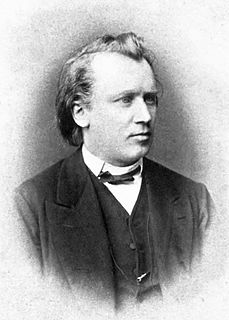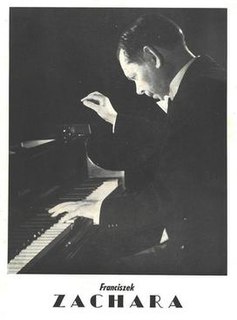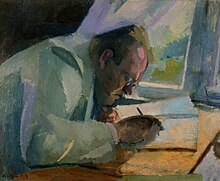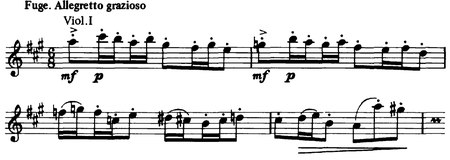The Variations on a Theme by Joseph Haydn,, now also called the Saint Anthony Variations, is a work in the form of a theme and variations, composed by Johannes Brahms in the summer of 1873 at Tutzing in Bavaria. It consists of a theme in B♭ major based on a "Chorale St Antoni", eight variations, and a finale. The work was published in two versions: for two pianos, written first but designated Op. 56b; and for orchestra, designated Op. 56a.
Symphony No. 103 in E♭ major is the eleventh of the twelve London symphonies written by Joseph Haydn. This symphony is nicknamed The Drumroll after the long roll on the timpani with which it begins. It is from 1795, and his second-to-last symphony.

The Symphony No. 1 in C minor, Op. 68, is a symphony written by Johannes Brahms. Brahms spent at least fourteen years completing this work, whose sketches date from 1854. Brahms himself declared that the symphony, from sketches to finishing touches, took 21 years, from 1855 to 1876. The premiere of this symphony, conducted by the composer's friend Felix Otto Dessoff, occurred on 4 November 1876, in Karlsruhe, then in the Grand Duchy of Baden. A typical performance lasts between 45 and 50 minutes.
The Young Person's Guide to the Orchestra, Op. 34, is a 1945 musical composition by Benjamin Britten with a subtitle Variations and Fugue on a Theme of Purcell. It was based on the second movement, "Rondeau", of the Abdelazer suite. It was originally commissioned for the British educational documentary film called Instruments of the Orchestra released on 29 November 1946, directed by Muir Mathieson and featuring the London Symphony Orchestra conducted by Malcolm Sargent; Sargent also conducted the concert première on 15 October 1946 with the Liverpool Philharmonic in the Philharmonic Hall, Liverpool, England.

Franciszek Zachara was a Polish pianist and composer who concertized extensively throughout Europe in the years leading up to 1928. He was a professor of piano at a Polish conservatory from 1922–1928, and two American colleges from around this time until his death in 1966. Zachara composed well over 150 works, including many works for piano solo, a piano concerto, a symphony, several works for band, and various chamber pieces. The archive of his manuscripts is held at the Warren D. Allen Music Library at Florida State University. Most of these manuscripts are originals from the composer's own hand.
Cello Concerto in E minor, Op. 58 is a concerto written by Sergey Prokofiev between 1933 and 1938. Its duration is approximately 35 minutes. It consists of three movements:
- Andante – Poco meno mosso – Adagio
- Allegro giusto
- Tema (allegro) – Interludio 1 – Variations 1–3 – Interludio 2 – Variation 4 – Reminiscenza – Coda – Più mosso
Rustic Wedding Symphony, Op. 26 is a symphony in E flat major by Karl Goldmark, written in 1875, a year before his renowned Violin Concerto No. 1. The symphony was premiered in Vienna on 5 March 1876, conducted by Hans Richter. Johannes Brahms, who was a frequent walking companion of Goldmark's, and whose own Symphony No. 1 was not premiered until November 1876, told him "That is the best thing you have done; clear-cut and faultless, it sprang into being a finished thing, like Minerva from the head of Jupiter". Its first American performance was at a New York Philharmonic Society concert, conducted by Theodore Thomas on 13 January 1877.
The String Sextet No. 1 in B♭ major, Op. 18, was composed in 1860 by Johannes Brahms and premiered 20 October that year in Hanover by an ensemble led by Joseph Joachim. It was published in 1862 by the firm of Fritz Simrock.
The Symphony No. 3 of Roger Sessions was written in 1957. It was a result of a commission by the Koussevitzky Foundation to celebrate the 75th anniversary of the Boston Symphony Orchestra, and was premiered by the Boston Symphony on December 6, 1957, conducted by Charles Munch. Sessions later was commissioned by the Boston Symphony on their centenary, when he provided them with his Concerto for Orchestra. Andrea Olmstead describes all of Sessions's symphonies as "serious" and "funereal", with No. 3 being one of four with, "quiet reflective endings."
In music, a duodecet—sometimes duodectet, or duodecimette—is a composition which requires twelve musicians for a performance, or a musical group that consists of twelve people. In jazz, such a group of twelve players is sometimes called a "twelvetet". The corresponding German word is Duodezett. The French equivalent form, douzetuor, is virtually unknown. Unlike some other musical ensembles such as the string quartet, there is no established or standard set of instruments in a duodecet.
The Piano Concerto No. 1 in D major, Op. 17, by Camille Saint-Saëns was composed in 1858, when the composer was 23 and dedicated to Marie Jaëll. It is the first piano concerto ever written by a major French composer.

Der 100. Psalm, Op. 106, is a composition in four movements by Max Reger in D major for mixed choir and orchestra, a late Romantic setting of Psalm 100. Reger began composing the work in 1908 for the 350th anniversary of Jena University. The occasion was celebrated that year with the premiere of Part I, conducted by Fritz Stein on 31 July. Reger completed the composition in 1909. It was published that year and premiered simultaneously on 23 February 1910 in Chemnitz, conducted by the composer, and in Breslau, conducted by Georg Dohrn.
Max Bruch's Romance for Violin and Orchestra in A minor, Op. 42, was composed in 1874. Bruch had intended the piece to form the first movement of a projected second violin concerto. However the composer found himself unable to progress beyond the first movement and chose to publish the work as a standalone concert piece dedicated to violinist Robert Heckmann who along with Joseph Joachim had assisted Bruch with the violin part.

Eine romantische Suite, Op. 125, is a suite for orchestra by Max Reger, based on poems by Joseph von Eichendorff. Reger described this suite, composed and first performed in 1912, and the Vier Tondichtungen nach A. Böcklin, Op. 128, as "Ausflug in das Gebiet der Programmusik".

Marius Flothuis, born and died in Amsterdam, was a Dutch composer, musicologist and music critic.

Camillo Schumann was a German late Romantic composer and organist.








